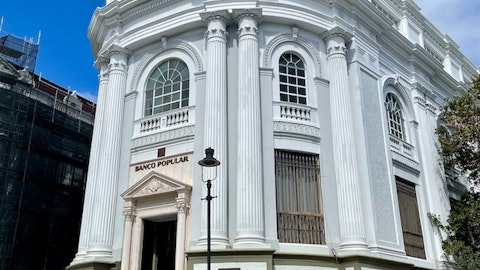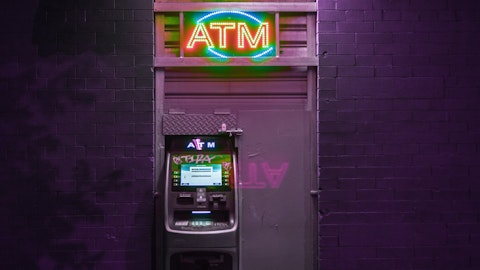Carlos Vazquez: Yes. Probably the colloquial answer to your question is we have — we hope we will have to have the decision on the investor portfolio extension because we have enough loan demand that we can put the maturities into loans. That will be our preferred outcome that are obviously the best use of our liquidity in terms of margin. You’re correct. I mean to the extent that Fed is done and the pressure on the funding side should be less. We are still originating loans at a higher rate level. So that should be helpful to margin. And the same is true of the investment portfolio. Whatever is coming due tends to be old treasuries or older investments that were at lower rates. So this — so that should be helpful as well. So those are the variables there. And the math will be whatever the math is.
Brett Rabatin: Okay. And then just lastly for me, the 14% ROTCE target by 2025. It seems like it’s possible but that might be shaped a little bit earlier if things line up relative to rates and loan growth. Any thoughts on timing of that target?
Carlos Vazquez: Well, the timing, we were very specific in our timing. It was not the end of 2025 and this target is not an easy target. So we’re working very hard to make sure we get there. God bless you and hope you’re right that we can get there earlier. But at this point in time, for us, it looks like the end of 2025.
Brett Rabatin: Okay, fair enough. Thanks for all the color.
Carlos Vazquez: Thanks.
Operator: Our next question comes from Alex Twerdahl of Piper Sandler. Alex, please go ahead.
Alexander Twerdahl: Hey, good morning.
Ignacio Alvarez: Hey, Alex.
Carlos Vazquez: Good morning.
Alexander Twerdahl: Just to expand upon that last question on the ROTCE target. When you guys initially set that out, I think it was back in January, and one could have assumed or maybe you guys assumed that buybacks to be part of the story this year, which they’re not. I’m just curious when you say it’s unchanged, is it just basically saying that you’re reiterating what you said back in — back in January? Or is there an update to the assumptions on capital levels incorporated into the reiterated guidance as well?
Carlos Vazquez: It’s unchanged.
Alexander Twerdahl: Okay. So you’re not making any changes to your thought around capital levels. You’re just from when you initially set the target out in January?
Carlos Vazquez: There obviously are assumptions in that number, and the assumptions were not made public and we’re not making them public now.
Alexander Twerdahl: Okay.
Ignacio Alvarez: But they’re unchanged.
Carlos Vazquez: They’re unchanged, yes.
Alexander Twerdahl: I want to ask the government deposit question slightly different — differently. Obviously, we’re very focused on the impact to your guys’ balance sheet. But looking at them a different way, it seems like there’s almost $18 billion of government deposits now that is basically cash that the Puerto Rican government has to eventually put to work into the economy, into various programs, into things that should continue to help the Puerto Rico picture. Is that accurate thinking?
Ignacio Alvarez: It is. But keep in mind that it’s a very diverse group of depositors. I think we estimate over 140 different deposit clients that have clients ranging from the Puerto Rico Treasury Department to small municipalities. Most of the agencies have much more money available now that they did. Now some of this money is specifically earmarked for program, so they can’t use it as they want. But definitely, things are happening, not only the Puerto Rico central government but the municipalities are deleveraging, which not only means that they have money to spend, which means in the future, in the economy as they have more room to borrow and to do other capital projects if they are good projects. So yes, that should be a similar effect.
But again, it’s 140 agencies with many different programs, some that are specifically earmarked. So we definitely — it’s obviously good for the economy. It’s good for the economy that the government across the board is deleveraging, which is — I think is important.
Alexander Twerdahl: Yes. When you talk about the earmarks, are there any like big ones out there that you kind of have line of sight on hitting in the next couple of months or years, I guess, years is too far. But next couple of quarters that would make that number change dramatically one way or another?
Ignacio Alvarez: No. But as we said in the prepared remarks, we have seen the pace of disbursement of federal funds increase during the year. So at this point in the year through — I think through August, the reason I saw about $2.8 billion had been dispersed. That compares to $1.7 billion last year. So the pace is picking up. We do see a lot of the infrastructure projects will continue to pick up pace. There’s a lot of products in the energy sector, a lot of on the water sectors, a lot of projects — there is a lot of highway projects going on. A lot of that is still in the planning, in the permitting, in the planning, that process. We do expect one area will pick up next year will be the CDBG-DR funds for housing. There’s a number of projects that have been awarded and those are projects where private developers build a series of houses, and the government will buy those houses from the developer and then later give it to people with vouchers for up like $230,000.




